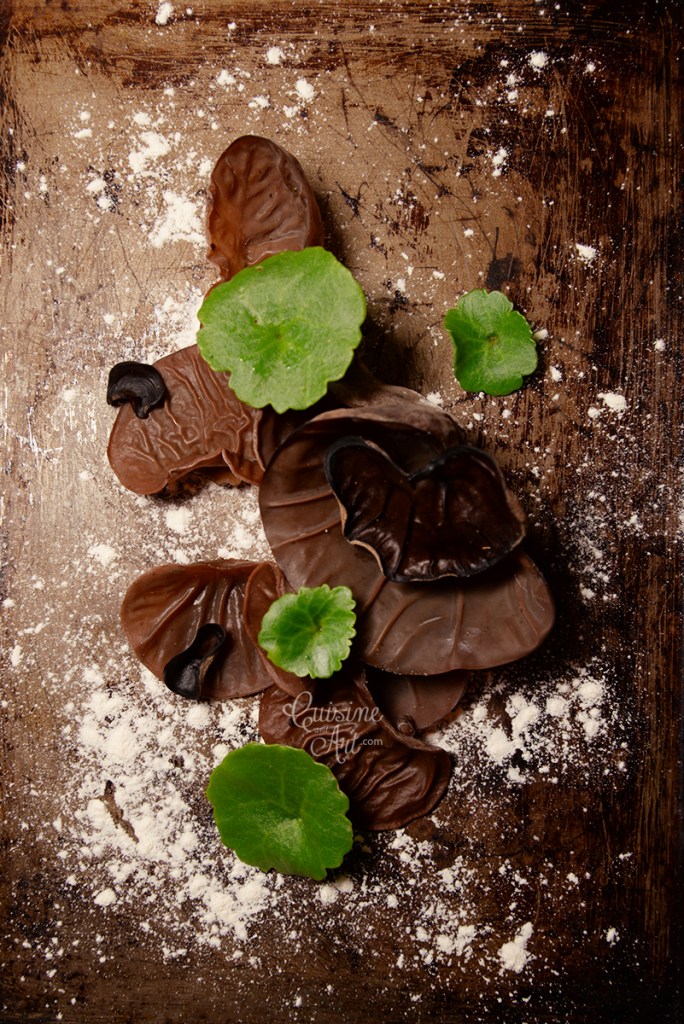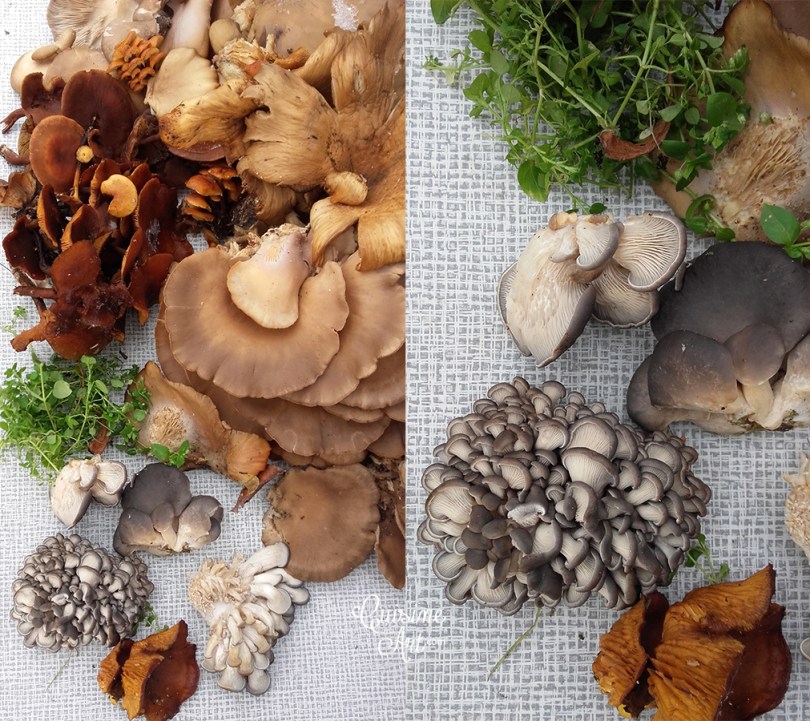above / powyżej: WILD WINTER MUSHROOMS – with many thanks to Filip Malinowski and @fundacjazdrowegozycia / ZIMOWE GRZYBÓW ZBIERANIE – z podziękowaniami dla Filipa oraz Fundacji Zrowego Życia BY CUISINE AND ART
For the last two years I have planted some walnut and oak trees. I buried a few walnuts and acorns in the back garden and now I stare at them with a big smile – 6 tiny trees which hopefully one day will be great big ones. What a beautiful green nursery!

Wilhelm Sasnal, Polish artist (1972) painted his “Forest” in 2002. Powerful vivid green space seems to be huge, massive, all surrounding. But it’s not. It’s quite a tiny forest – 45cm by 45cm only! To create such a powerful image on just 2025cm² is a magic trick or perhaps a very personal, intimate image of the artist’s own world?
I cannot imagine my life without a forest nearby. Forest was everywhere. Always. As was the sea. First it was coniferous. Later deciduous. Afterwards there was a gap – no forest at all for a couple of months, which seemed like forever (luckily at least the sea was a few hundred meters away). For the lack of it I couldn’t stay there any longer and I moved to a place with a eucalyptus forest, where every October and November I was collecting parasol mushrooms in almost wholesale quantities. It seemed that the Catalans don’t like them at all, even though they are (Catalans not the mushrooms!) a foraging nation. Better for me, I thought! I never, and I mean NEVER, had so many parasols! I started to dry them and to freeze them, because I couldn’t eat them any more for every breakfast, lunch and supper! At the same time I was collecting slippery jack mushrooms amongst the palm trees next to the beach. Of course every Catalan passing by warned me of the probable deadly danger of eating these small slimy beauties, which I have eaten in quantity throughout my whole life.
Forest is a scent for me. It is space. Silence. And last, but not least, foraging! Billberries, blackberries, raspberries, lingonberries, cranberries and mushrooms. But most of all mushrooms! I’m always looking for them. Everywhere. Since last year I’ve been looking for them also in winter. Yes, in winter! But on the … trees!!! You can imagine how difficult it was to switch to looking for mushrooms above ground level! It was January, Gdynia, on the Polish coast, where Filip Malinowski from the Healthy Life Foundation organized and led a workshop on foraging for wild winter mushrooms. It was great fun and then a delicious feast after freezing work – stewed mushrooms on the campfire with a small side salad from wild plants Filip had found (he also organizes wild plant foraging workshops, you can check it on the fb profile @fundacjazdrowegozycia and/or write to him in English!).
The smell of Scots pine trees. The smell of hot summer in the Tuchola Forest of northern Poland. The aroma of eucalyptus and pine trees of southern Europe. The scent of wet decomposing leaves in the Tri-City forests (Tri-City is a metropolitan area in Poland consisting of three cities in the Pomerania region: Gdańsk – my hometown, Gdynia and Sopot). I close my eyes – I can see and feel every tree. I wander along known paths. I discover new ones.
From the young parasol mushrooms found today along the road, I make a small starter in the style of Spanish “tapas”. Because nothing is wasted in my kitchen – I serve them on toasted stale bread (Even bread dry as a bone after heating in a toaster becomes not only edible but also delicious!). It’s great that the parsley has sprouted a few new leaves – they will be perfect for my wild appetizer!

FRIED PARASOL MUSHROOMS ON TOASTED STALE BREAD WITH GARLIC AND PARSLEY
– 2 young parasol mushrooms
– 1 clove garlic
– salt
– black pepper
– 2 slices of old, dry, stale bread
– olive oil for frying
Heat the frying pan, add a splash of olive oil and sliced parasol mushrooms. Wait until they start to be beautifully brown, almost golden. Add crushed garlic, salt and pepper. Put the bread into a toaster. Wait for the mushrooms to be fried and golden. Add some chopped parsley. Serve on warm toasted bread.
SASNAL, LAS, KANIE I STARY SUCHY CHLEB
Zasadziłam dwa lata temu i w roku ubiegłym orzechy włoskie i dęby. Wsadziłam do ziemi kilka orzechów i żołędzi, a teraz z ogromną przyjemnością patrzę na 6 orzechowych drzewek i 2 maleńkie dąbki. Radosne zielone przedszkole!
Soczyście zielony las Sasnala wbrew pozorom jest niewielkim laskiem. Namalowany w 2002 roku ma zaledwie 45 cm na 45 cm. Drobnych 2025 centymetrów kwadratowych będących siłą, będących potęgą, będących wszystkim! Magiczna sztuczka czy po prostu bardzo prywatny, osobisty, intymny świat artysty?
Nie jestem nawet w stanie sobie wyobrazić życia bez lasu w pobliżu. Las był wszędzie. Zawsze. Jak morze. Najpierw iglasty. Potem liściasty. Potem nastąpiła przerwa trwająca kilka miesięcy, wydających się jednak wiecznością, kiedy to lasu nie było (morze a i owszem). Z braku tegoż miejsce szybko zmieniłam na las eukaliptusowy, w którym każdego października i listopada zbierałam kanie, których nikt z katalońskich tubylców nie tykał, choć to naród zbieraczy. Nigdy w życiu tylu kani nie miałam! Nigdy! Zaczęłam je suszyć i mrozić, bo nie byłam już w stanie ich jeść na śniadania, obiady i kolacje. Wśród palm i pinii zbierałam również maślaki, przed którymi miejscowi próbowali mnie chronić, głośno krzycząc, że się z całą pewnością otruję!
Las to dla mnie zapach. To przestrzeń. Wyciszenie. I zbieractwo. Jagody, maliny, jeżyny, borówki, żurawiny i grzyby. Przede wszystkim grzyby! Zawsze ich szukam. Wszędzie. A od ubiegłego roku szukam ich również zimą … drzewach! Tak, trudno się było przestawić na poszukiwanie „na górze”, ale Filip Malinowski, prowadzący warsztaty w Gdyni-Orłowie, przekonał mnie i do tego. Było genialnie! Było zimno i przepysznie, kiedy dusiliśmy je na patelni na ognisku. Polecam! Poczekajcie do zimy, obserwujcie na fb profil Fundacji Zdrowego Życia (@fundacjazdrowegozycia) i już – na grzyby do Gdyni albo do Torunia, bo tam Filip również robi warsztaty. Zresztą nie tylko ze zbierania grzybów, ale i jadalnych dzikich roślin.

Zapach sosen. Upalnego lata w Borach Tucholskich. Aromat eukaliptusów i pinii południowej Europy. Mokre liście zaczynające się rozkładać w lasach trójmiejskich. Zamykam oczy i widzę, czuję każde drzewo. Wędruję znanymi ścieżkami. Odkrywam nowe. A z młodych kani, znalezionych dziś przy drodze, robię niewielka przystawkę w stylu hiszpańskich „tapas”. A ponieważ w mojej kuchni nic się nie marnuje – podaję je na opieczonym czerstwym chlebie (nawet bardzo suche pieczywo po opieczeniu w tosterze staje się nie tylko zjadliwe, ale i przepyszne!). Dobrze, że pietruszka wypuściła kilka liści – nada się w sam raz do kani!
SMAŻONE KANIE Z PIETRUSZKĄ I CZOSNKIEM NA OPIEKANYM CZERSTWYM PIECZYWIE
– 2 młode kanie
– 1 ząbek czosnku
– sól
– pieprz
– pietruszka
– 2 kromki czerstwego, suchego pieczywa
– oliwa z oliwek do smażenia
Rozgrzej patelnię, wlej trochę oliwy z oliwek. Wrzuć pokrojone w paski kanie. Podsmaż aż zaczną się rumienić. Dodaj rozgnieciony w prasce czosnek, sól, pieprz. W międzyczasie wrzuć pieczywo do tostera. Do zarumienionych usmażonych grzybów dodaj pietruszkę. Podawaj na gorącym opieczonym chlebie.

